Table of Contents
Introduction
Artificial Intelligence in Military Statistics: The integration of Artificial Intelligence (AI) into military operations marks a transformative shift in defense, leveraging machine learning, robotics, natural language processing, and computer vision to enhance decision-making, efficiency, and tactical advantages.
These technologies underpin a wide array of applications, from autonomous drones and cybersecurity defenses to predictive logistics and advanced training simulations. Fundamentally altering the landscape of military strategies and operations.
While offering significant benefits in operational precision and risk reduction, the deployment of AI in the military sphere also raises critical ethical and legal questions. Particularly concerning autonomous weaponry and the delegation of critical decisions to machines.
This evolution demands careful navigation of ethical frameworks, regulatory measures, and strategic considerations. Underscoring the pivotal role of AI in shaping future defense mechanisms and international security dynamics.
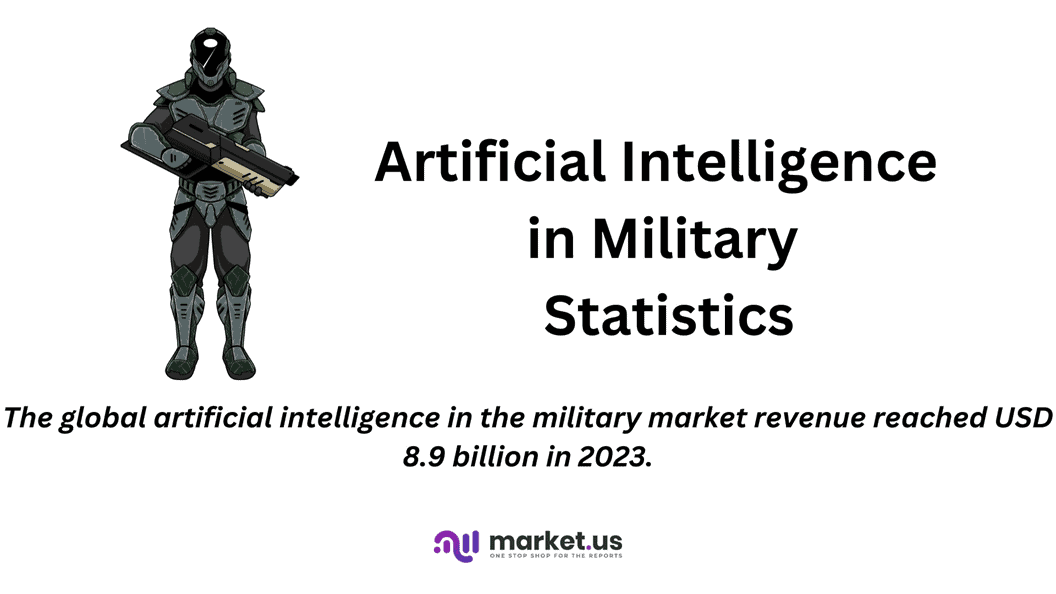
Editor’s Choice
- The global artificial intelligence in the military market revenue reached USD 8.9 billion in 2023.
- By 2032, the market is expected to surge to USD 24.7 billion, with software, hardware, and services revenues reaching USD 10.52 billion, USD 8.00 billion, and USD 6.18 billion, respectively.
- In the distribution of market share by platform within the artificial intelligence in the military sector. Space platforms lead with a substantial 33%, underscoring the increasing reliance on and investment in satellite technologies, space surveillance, and other extra-terrestrial applications of AI.
- In 2018, 44% of organizations utilized AI to detect and deter security intrusions, demonstrating the critical role of AI in safeguarding digital infrastructures.
- In terms of military expenditure, the United States leads globally with a staggering $877 billion, constituting 3.5% of its GDP.
- Notably, the Pentagon has revised its autonomous weapons policy to reflect advancements in AI since the original 2012 policy.
- 59% of respondents identify the lack of data-science specialists as the main hurdle in implementing big-data-driven AI technologies.
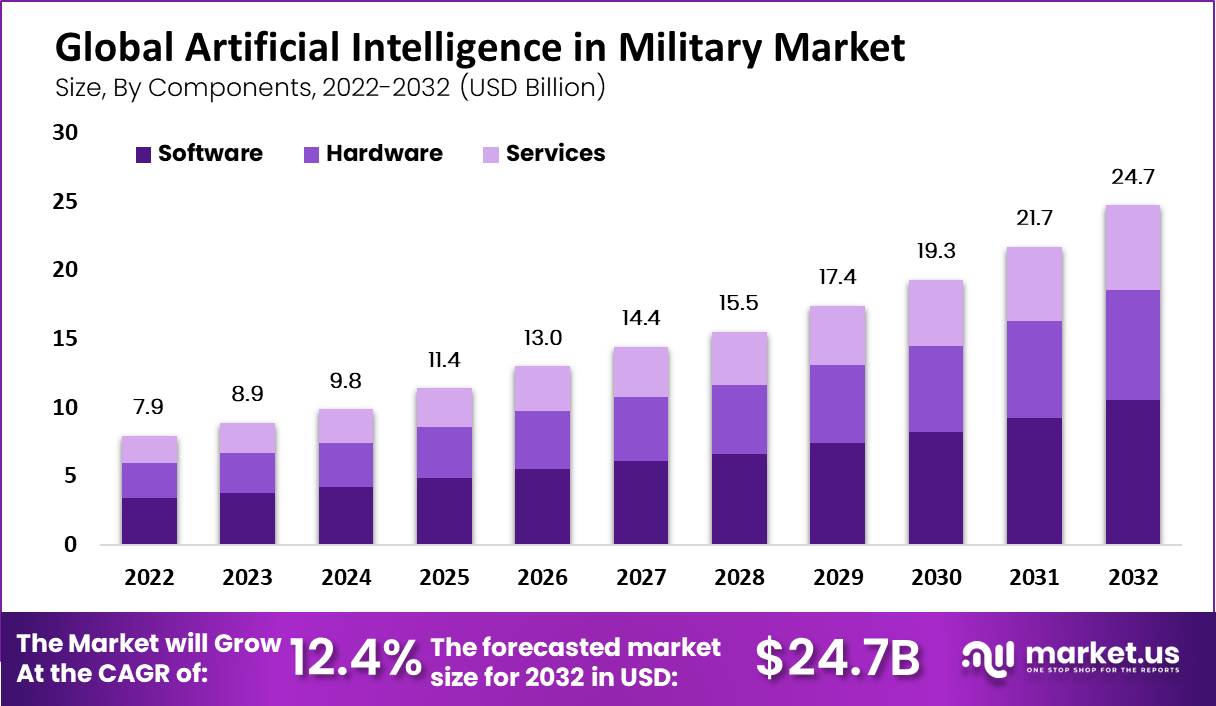
AI in Military Market Overview
Global Artificial Intelligence in Military Market Size Statistics
- The global artificial intelligence in the military market has exhibited a steady growth trajectory from 2022 through 2032 at a CAGR of 12.4%.
- Starting at a revenue of USD 7.9 billion in 2022, the market experienced annual growth. Reaching USD 8.9 billion in 2023 and further ascending to USD 9.8 billion in 2024.
- This upward trend continued with the market size expanding to USD 11.4 billion in 2025. Followed by an increase to USD 13.0 billion in 2026 and then to USD 14.4 billion in 2027.
- The growth momentum sustained, with the market value rising to USD 15.5 billion in 2028, USD 17.4 billion in 2029, and USD 19.3 billion in 2030.
- Looking forward, the market is projected to achieve USD 21.7 billion in 2031, culminating in a substantial increase to USD 24.7 billion by 2032.
- This consistent growth underscores the increasing integration and reliance on artificial intelligence technologies within military operations globally. Reflecting both the expanding applications of AI in defense strategies and the burgeoning investment in this sector.
(Source: Market.us)
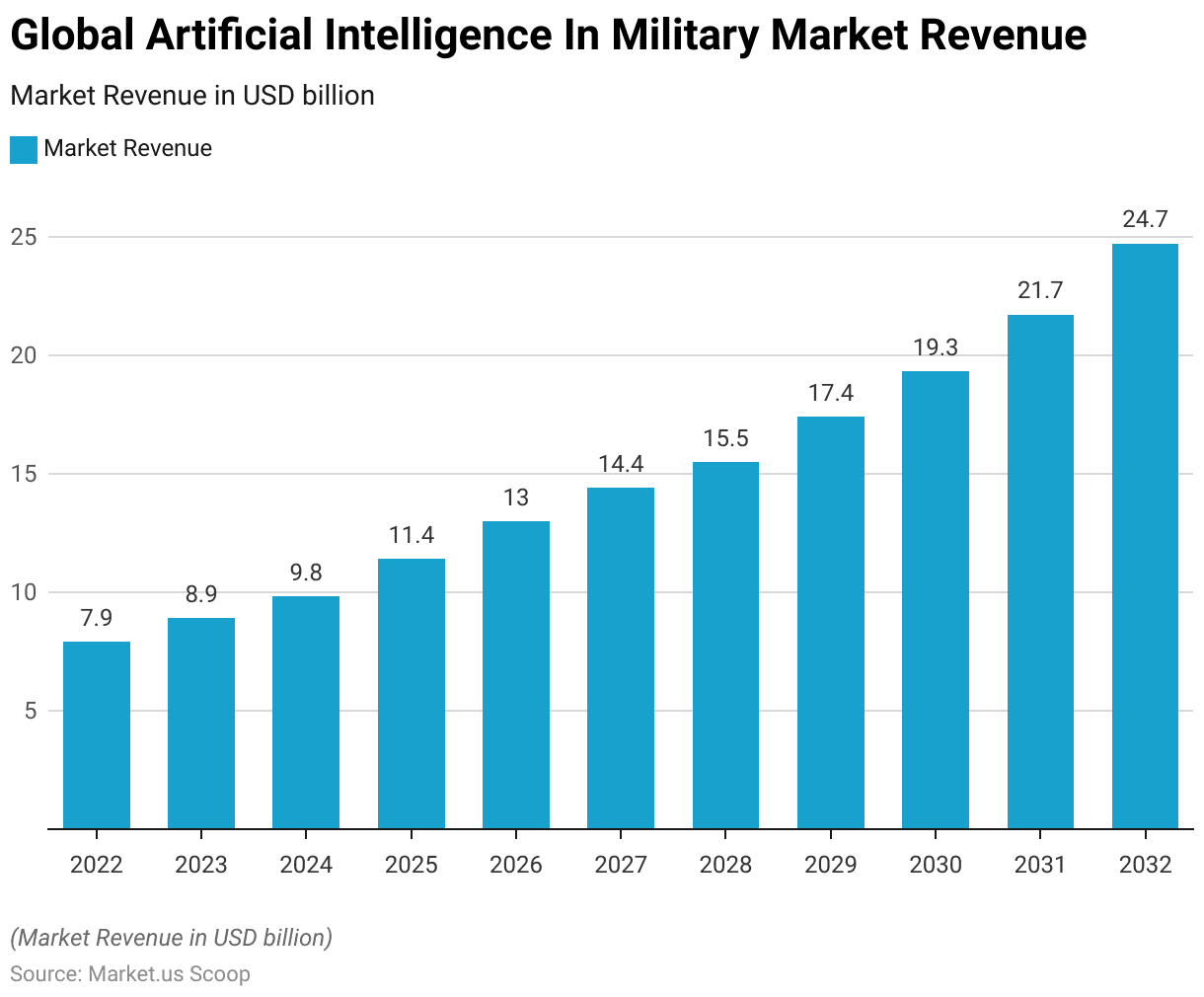
Artificial Intelligence in Military Market Size – By Component Statistics
- The global market for artificial intelligence in the military has seen significant growth and diversification across its components from 2022 to 2032.
- In 2022, the market started with a total revenue of USD 7.9 billion, divided into software, hardware, and services revenues of USD 3.37 billion, USD 2.56 billion, and USD 1.98 billion, respectively.
- By 2023, the market grew to USD 8.9 billion, with software revenue increasing to USD 3.79 billion, hardware to USD 2.88 billion, and services to USD 2.23 billion.
- This upward trajectory continued, reaching a market size of USD 9.8 billion in 2024, with further increases in all components.
- By 2025, the market expanded to USD 11.4 billion, followed by a rise to USD 13.0 billion in 2026 and USD 14.4 billion in 2027. Showcasing consistent growth in software, hardware, and services.
- The market momentum sustained, reaching USD 15.5 billion in 2028, USD 17.4 billion in 2029, and USD 19.3 billion in 2030, with corresponding increases across the three components.
- Projected figures for 2031 show a market size of USD 21.7 billion. By 2032, the market is expected to surge to USD 24.7 billion, with software, hardware, and services revenues reaching USD 10.52 billion, USD 8.00 billion, and USD 6.18 billion, respectively.
- This progression highlights the growing importance of AI technologies in military applications. Driven by advancements and investments in software, hardware, and associated services.
(Source: Market.us)
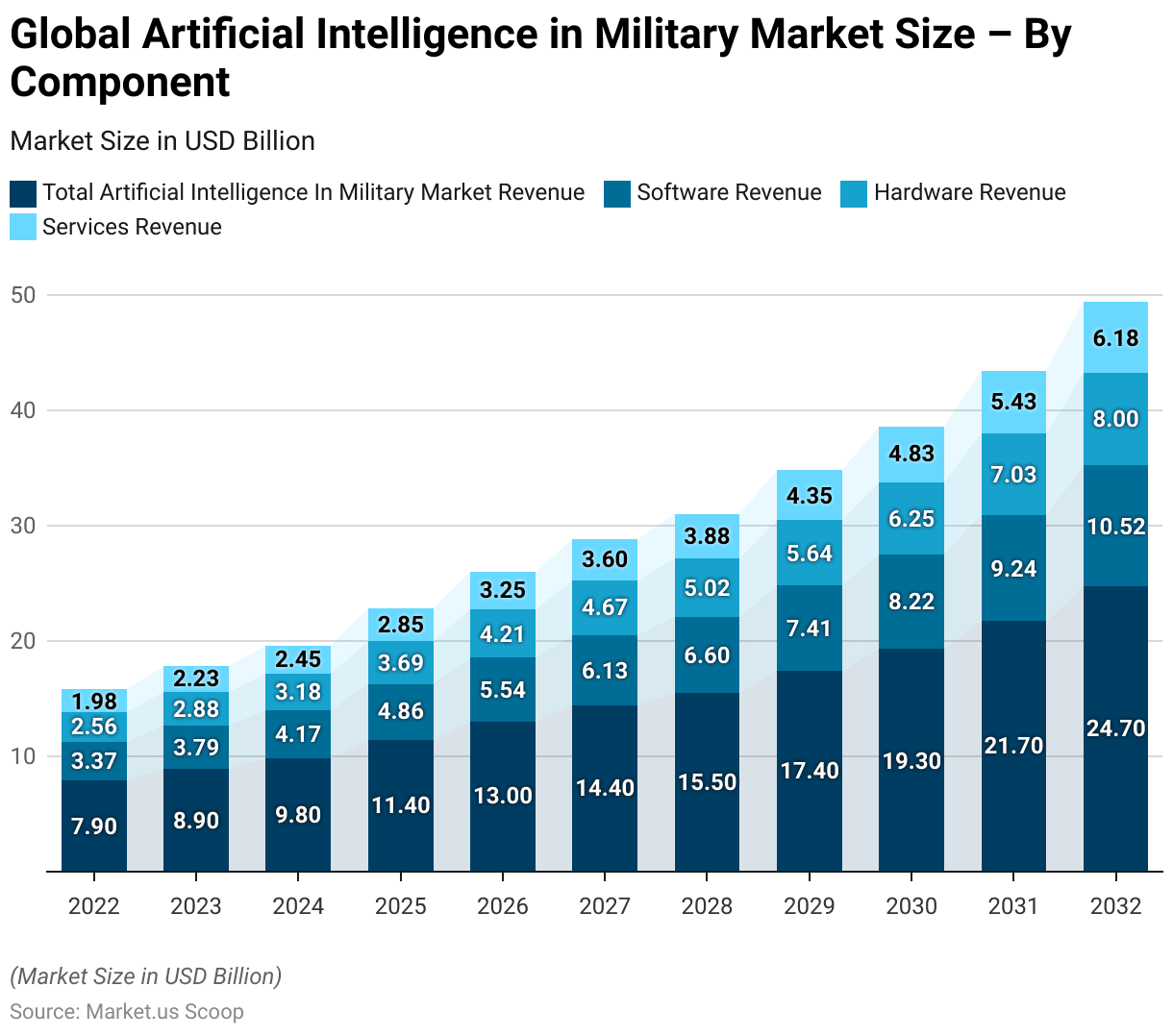
Global Artificial Intelligence in Military Market Share – By Platform Statistics
- In the distribution of market share by platform within the artificial intelligence in the military sector. Space platforms lead with a substantial 33%, underscoring the increasing reliance on and investment in satellite technologies, space surveillance, and other extra-terrestrial applications of AI.
- Land platforms follow closely, holding a 29% share, reflecting the significant incorporation of AI in ground operations, including autonomous vehicles, robotics, and surveillance systems.
- Airborne platforms account for 21% of the market, highlighting the importance of drones. Fighter jet support systems, and other aerial applications in modern military strategies.
- Lastly, naval platforms constitute 17% of the market share, indicating a solid investment in AI for unmanned underwater vehicles, shipboard systems, and maritime surveillance.
- This distribution showcases the multifaceted approach to integrating AI across various military domains, each contributing uniquely to enhancing operational capabilities and strategic defense mechanisms.
(Source: Market.us)
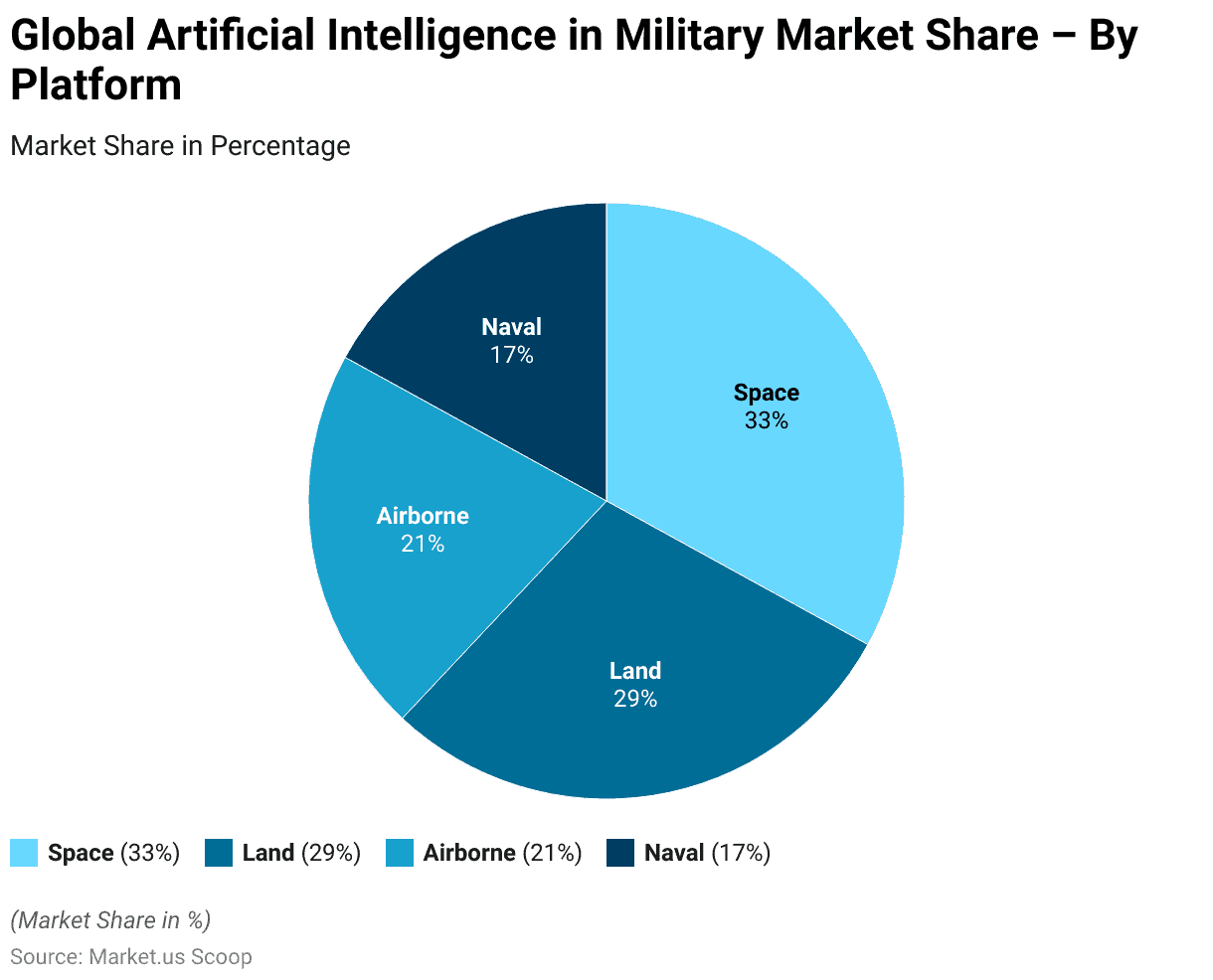
Military Artificial Intelligence (AI) and Cybernetics Market Revenue – By Service Statistics
- The revenue generated by the military artificial intelligence (AI) and cybernetics market worldwide exhibited significant growth between 2018 and 2024 across various service categories.
- In 2018, hardware services accounted for $960.7 million, which surged to $2601.4 million by 2024, showcasing a remarkable increase.
- Similarly, software services witnessed substantial growth, escalating from $2887.6 million in 2018 to $8066.3 million in 2024.
- Services, including consulting and maintenance, also experienced a noteworthy rise in revenue, climbing from $917.6 million in 2018 to $2437.6 million in 2024.
- This upward trend underscores the increasing investment and adoption of AI and cybernetics solutions within the military sector, driven by the need for advanced technological capabilities to address evolving security challenges.
(Source: Statista)
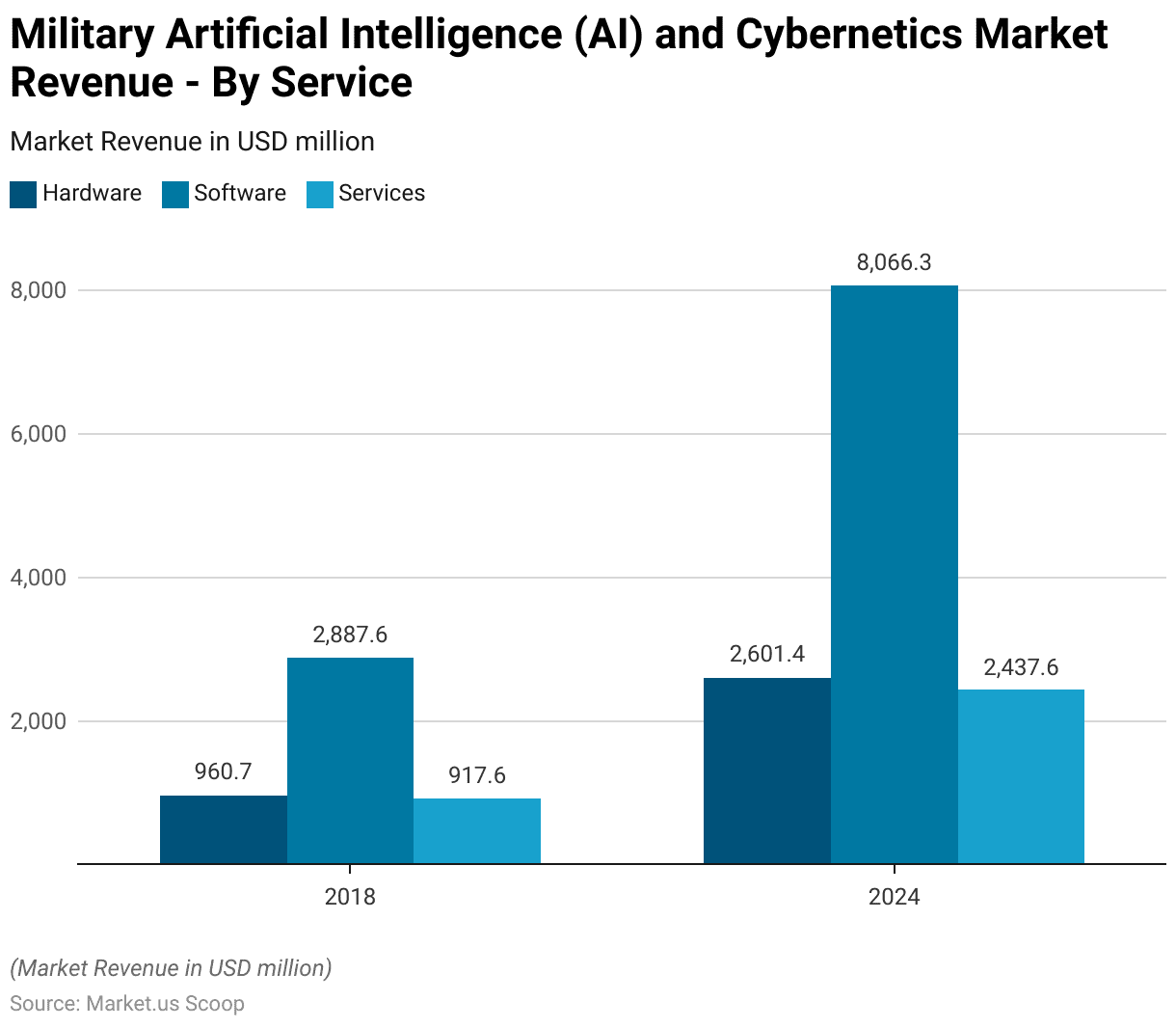
Application Areas of Artificial Intelligence (AI) in Organizations Worldwide
- In 2018, organizations worldwide embraced artificial intelligence (AI) across a diverse range of application areas to enhance operational efficiency and strategic decision-making.
- Leading the charge, 44% of organizations utilized AI for detecting and deterring security intrusions, demonstrating the critical role of AI in safeguarding digital infrastructures.
- Close behind, 41% applied AI solutions to resolve user technology problems, streamlining IT support and enhancing user experience.
- Both reducing product management work and gauging internal compliance through automation were priorities for 34% of organizations. Highlighting AI’s capability to streamline complex processes and ensure regulatory adherence.
- Anticipating future customer purchases was an application area for 19% of organizations. Showcasing AI’s predictive analytics prowess in understanding consumer behavior.
- Financial trading and runbook automation were identified by 17% and 16% of organizations. Respectively, as areas benefiting from AI’s real-time analytical and process automation capabilities.
- Similarly, improving media buying, monitoring social media comments, and tailoring promotions each attracted 16% of organizations. Reflecting AI’s growing influence in marketing and social engagement strategies.
- Lastly, automating call distribution was leveraged by 15% of organizations, indicating AI’s role in optimizing customer service operations.
- This wide array of application areas illustrates the versatile impact of AI technologies in transforming various facets of organizational operations and strategy.
(Source: Statista)
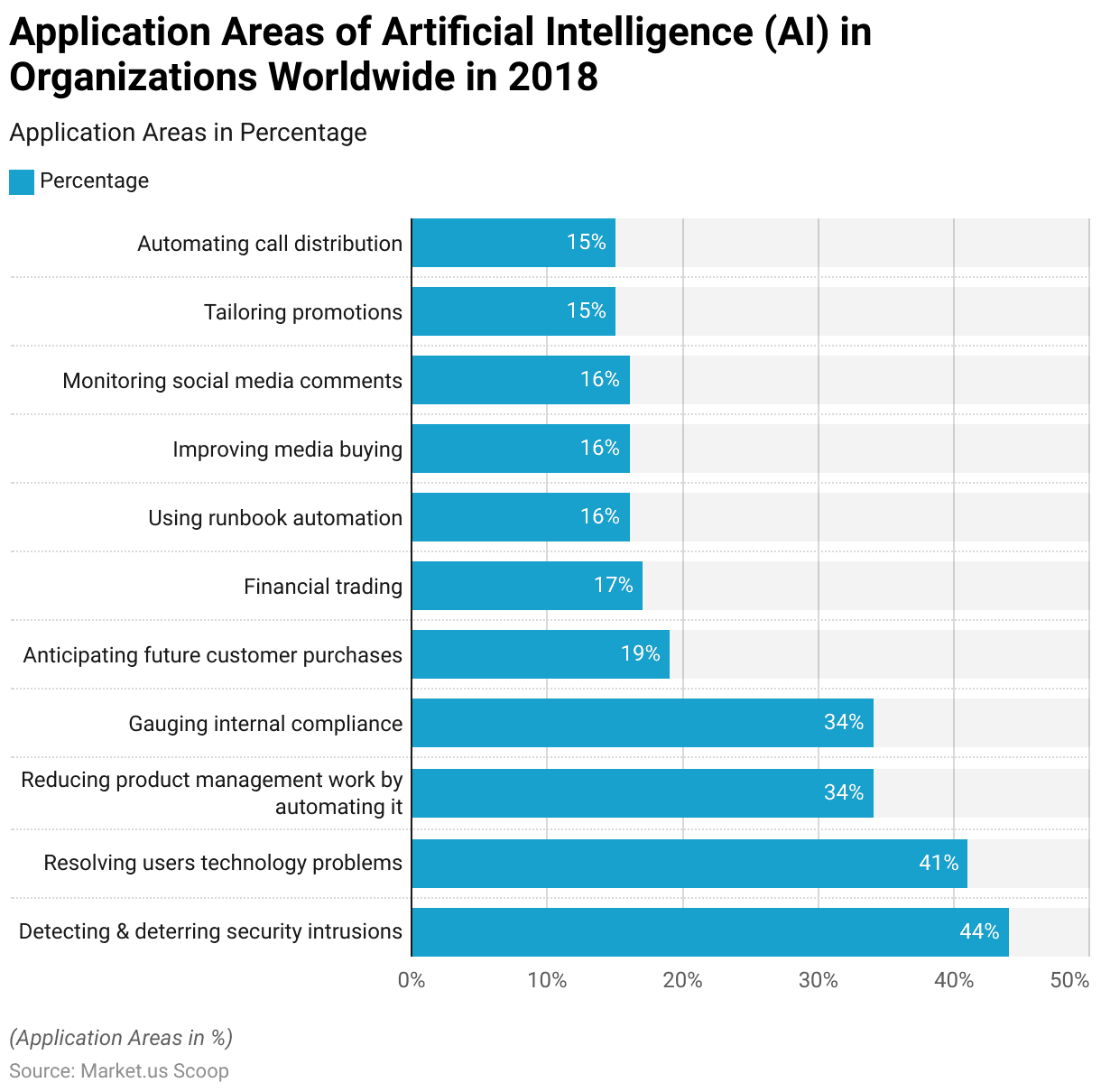
Military Spending of Various Nations
- In terms of military expenditure, the United States leads globally with a staggering $877 billion, constituting 3.5% of its GDP.
- Following closely behind is China, allocating $292 billion to its military. Albeit at a lower proportion of GDP, standing at 1.6%. Russia, with $86 billion, directs a significant 4.1% of its GDP towards defense.
- India’s military spending amounts to $81 billion, representing 2.4% of its GDP.
- Notably, Saudi Arabia allocates $75 billion, the highest share of GDP among the listed countries, at 7.4%.
- The United Kingdom and Germany spent $68 billion and $56 billion, respectively, with shares of GDP at 2.2% and 1.4%.
- France follows closely with $54 billion, equivalent to 1.9% of its GDP. South Korea and Japan both allocate $46 billion, with shares of GDP at 2.7% and 1.1%, respectively.
- These figures underscore the diverse approaches nations take regarding military expenditure relative to their economic capacities and security priorities.
(Source: Wisevoter)
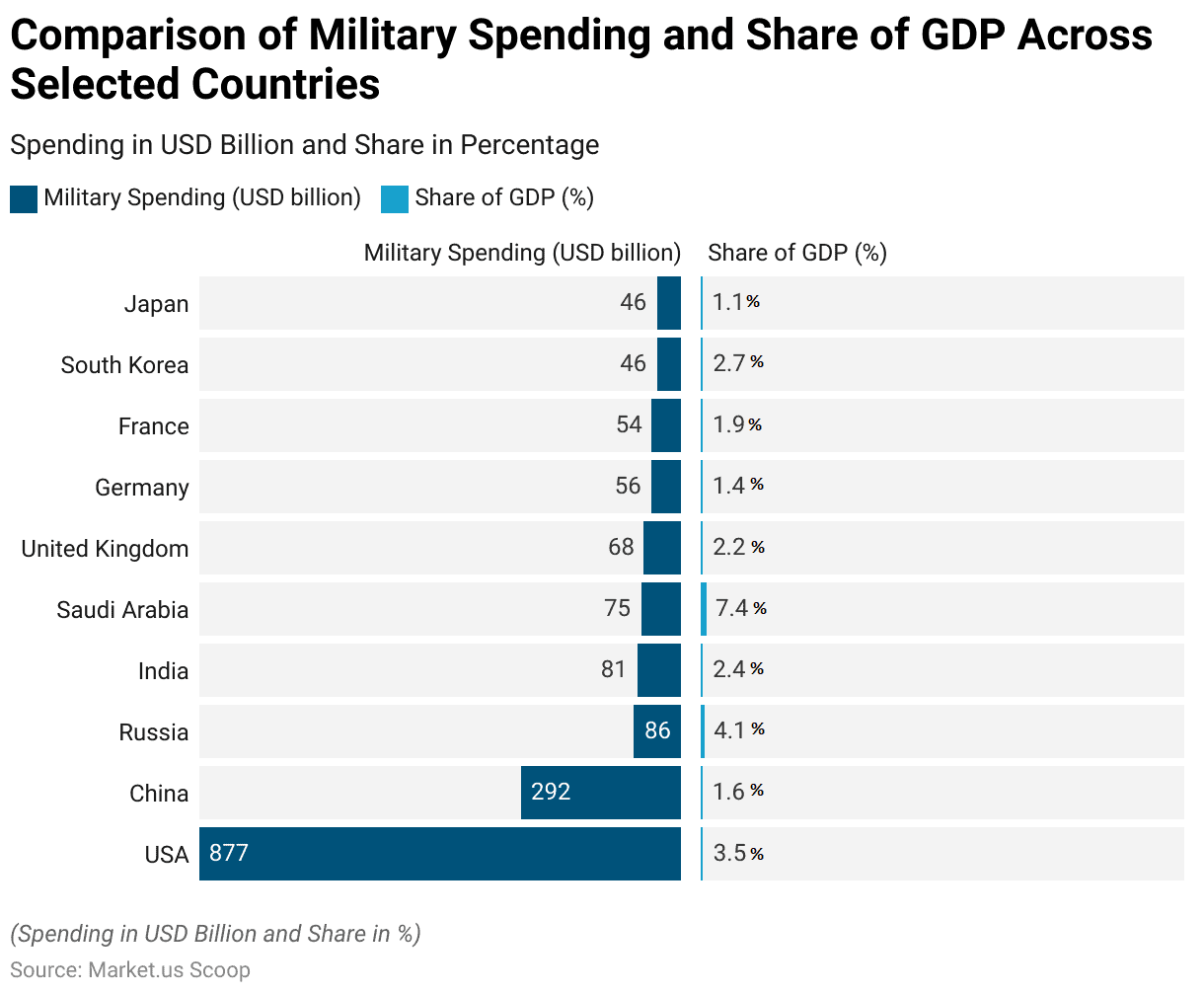
Military Applications of AI
Warfare Systems
- AI’s integration into warfare systems like weapons, sensors, and surveillance is enhancing operational efficiency and reducing human dependency, which may lead to decreased maintenance needs.
- The automation provided by AI minimizes human error and allows personnel to focus on critical tasks.
- Notably, the Pentagon has revised its autonomous weapons policy to reflect advancements in AI since the original 2012 policy.
- This update ensures the safe and ethical deployment of autonomous weapons, which are among the most significant military applications of AI.
- It includes stricter review and testing protocols and establishes a dedicated working group to guide the Department of Defense on autonomous weapons systems.
(Source: Defence News)
Drone Swarms
- Swarm intelligence in drone operations is a rapidly evolving military application of AI. Significantly enhancing effectiveness beyond what a single drone can achieve.
- In these swarms, when one drone acquires crucial data, it can respond directly or share the information with the group.
- Such swarms are not only beneficial in simulations and training exercises but also in real-world missions, offering versatile decision-making capabilities.
- While the swarm operates towards a common goal, each drone retains the autonomy to pursue that objective in innovative ways.
(Source: Sentient Digital, Inc.)
Target Recognition
- AI significantly enhances target recognition accuracy in combat by improving systems’ ability to pinpoint targets.
- It enables defense forces to gain comprehensive insights into operational areas through rapid analysis of various information sources, including reports and news.
- Additionally, generative AI facilitates interactive discussions, allowing military decision-makers to extract pertinent information efficiently.
- AI systems can predict enemy behavior, identify vulnerabilities, and consider weather conditions to advise on mission strategies and mitigation plans.
- This not only conserves time and resources but also ensures soldiers maintain a strategic advantage, with humans ultimately making critical decisions.
(Source: Sentient Digital, Inc.)
Threat Monitoring
- AI-driven unmanned systems and drones enhance threat monitoring and situational awareness in military operations.
- These technologies can be remotely operated or programmed to follow predetermined paths. Assisting defense personnel in threat detection and improving their overall situational awareness.
- AI-equipped drones are particularly useful for patrolling border regions, identifying potential threats, and notifying response teams.
- Moreover, they contribute to the security of military installations and the safety of soldiers in combat zones.
(Source: Sentient Digital, Inc.)
Transportation
- AI significantly enhances the logistics and transportation of ammunition, goods, armaments, and troops, which are crucial for military operations’ success.
- By optimizing travel routes for efficiency under current conditions and pre-emptively identifying issues in military fleets, AI reduces transportation costs and lessens the need for human intervention.
- Additionally, advancements in computer vision and autonomous decision-making are propelling self-driving vehicles toward commercial use. A development that holds promising applications in the military sphere as well.
(Source: Sentient Digital, Inc.)
Challenges and Concerns
- 59% of respondents identify the lack of data-science specialists as the main hurdle in implementing big-data-driven AI technologies.
- Meanwhile, 76% of business leaders view data bias and transparency issues as their top concerns regarding AI adoption.
- Additionally, 40% of executives cite cost and insufficient expertise as the primary obstacles to investing in AI.
- Furthermore, 37% of business leaders feel their managers lack the understanding of cognitive technologies like AI needed to secure a positive return on investment.
(Source: MicroSourcing)
Recent Developments
Acquisitions and Mergers:
- Acquisition of a defense AI startup by a leading defense contractor in September 2023, enhancing their capabilities in autonomous systems and battlefield intelligence.
- The merger between two AI technology companies specializing in military applications in December 2023, pooled their resources to develop advanced AI-driven solutions for defense.
New Product Launches:
- Introduction of AI-powered drones equipped with autonomous navigation and target recognition capabilities by defense manufacturers in January 2024, improving reconnaissance and surveillance missions.
- Launch of AI-based decision support systems for military command and control operations by defense software firms in March 2024, enabling faster and more informed decision-making on the battlefield.
Funding Rounds:
- Series C funding round for an AI defense contractor in February 2024, raising $100 million to scale up production of AI-enabled military systems and expand into new markets.
- Seed funding for a defense AI research institute in April 2024, securing $20 million to advance AI algorithms for military applications and conduct collaborative research with government agencies.
Partnerships and Collaborations:
- Collaboration between a military research agency and a tech consortium in November 2023 to develop AI-driven solutions for autonomous vehicles and unmanned aerial systems (UAS) in military operations.
- The partnership between a defense contractor and a cybersecurity firm in March 2024 to integrate AI-powered threat detection and response capabilities into military networks and systems.
Technological Advancements:
- Development of AI algorithms for predictive maintenance of military equipment, optimizing maintenance schedules, and reducing downtime for critical assets.
- Integration of AI into military training simulations and virtual reality environments for realistic and immersive training experiences for personnel.
Investment Landscape:
- Venture capital investments in AI military startups totaled $3.5 billion in 2023, with a focus on companies offering innovative AI solutions for defense applications.
- Strategic partnerships and acquisitions between defense contractors, technology firms, and research institutions accounted for 60% of total investment activity in the AI military market in 2023, reflecting industry efforts to leverage AI technologies for military modernization and readiness.
Conclusion
Artificial Intelligence in Military Statistics – The integration of Artificial Intelligence (AI) into military operations offers significant opportunities to improve operational effectiveness, decision-making, and technological advantage.
AI has been pivotal in enhancing functions such as autonomous operations, surveillance, logistics, and threat detection, reducing human risk, and increasing efficiency.
However, its rapid adoption brings substantial ethical, legal, and operational challenges. As AI evolves, military leaders and policymakers must establish strong ethical guidelines and frameworks to manage these challenges and use AI responsibly.
The continuous development of AI will play a crucial role in shaping future military strategies and necessitates ongoing evaluation and adaptation to new advancements and issues.
FAQs
Artificial intelligence in the military refers to the use of AI technologies such as machine learning, natural language processing, robotics, and computer vision to enhance decision-making, operational efficiency, and tactical capabilities in military settings.
AI is used in a variety of military operations, including autonomous vehicle navigation, surveillance, target recognition, threat analysis, cybersecurity, logistic optimizations, and more. It helps to process vast amounts of data quickly and accurately, improving response times and strategic decisions.
The benefits of using AI in the military include increased operational efficiency, reduced human casualties. Enhanced precision in targeting and intelligence operations, improved data processing and situational awareness, and the ability to perform complex tasks autonomously.
Ethical concerns include the autonomy of lethal decision-making systems, the potential for AI-controlled weapons to malfunction or be hacked. The lack of transparency in AI decision processes, and the broader implications of AI in warfare. Such as the escalation of conflicts and changes in international power dynamics.
Autonomous weapons systems are subject to both national and international laws and regulations. Many countries are working towards establishing specific guidelines that govern the development, deployment, and use of autonomous weapons to ensure they comply with international humanitarian law and ethical standards.
Discuss your needs with our analyst
Please share your requirements with more details so our analyst can check if they can solve your problem(s)



